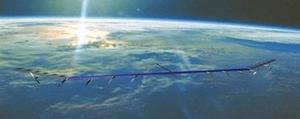UAV updateNew UAV to loiter the sky for five years without landing
Boeing has been given $89 million to build Vulture — a large solar-powered UAV intended to cruise the stratosphere for five years without landing; the idea is to achieve a platform which combines the good qualities of both satellites and aircraft with none of the downsides of either

Boeing's Vulture with a 5-year flight time // Source: aviationweek.com
Boeing has beaten its competitors and landed an $89 million contract to build the Vulture, a large solar-powered UAV intended to cruise the stratosphere for five years without landing.
The idea behind Vulture is to achieve a platform which combines the good qualities of both satellites and aircraft with none of the downsides of either. According to a DARPA statement issued yesterday:
Vulture technology enables a re-taskable, persistent pseudo-satellite capability in an aircraft package. The technology combines the key benefits of an aircraft (flexibility & responsiveness, sensor resolution, reduced transmit/receive power, affordable deployment) with the benefits of a satellite (on-station persistence, no logistics tail, zero emissions, energy independence, minimal fleet size, absence of in-country footprint). The system has potential in numerous roles: operation as a single platform, as a formation of multiple aircraft or as a constellation providing infrastructure augmentation or recovery.
“The Vulture technology shatters some fundamental aviation and space paradigms”, says Daniel Newman, DARPA program manager.
Lewis Page writes that according to Boeing the initial demonstrator craft will be based on the SolarEagle prototype developed by the firm’s advanced-concepts lab, the Phantom Works. Boeing adds that U.K. company Qinetiq will be a “key supplier” to the project, suggesting that the Vulture will also include technology from Qinetiq’s Zephyr sun-plane (“Three companies compete for a long-endurance UAV concept,” 17 September 2008 HSNW; and “Boeing chooses Qinetiq for Vulture program,” 28 July 2008 HSNW).
The Vulture demonstrator will have a wingspan of 400 feet and its propellers will be spun by electric motors. Surplus solar energy will be stored during the day using fuel cells in order to keep the aircraft flying — and power the payload systems — through the night. The initial test flight is intended to last thirty days, as a start toward the program goal of five-year endurance.
Page notes that other technologies are being investigated for long-endurance flight at high altitudes, both by DARPA and other agencies. These include hydrogen-fuelled aeroplanes as opposed to solar powered ones, and also airships both solar and gaseous-fuelled.
